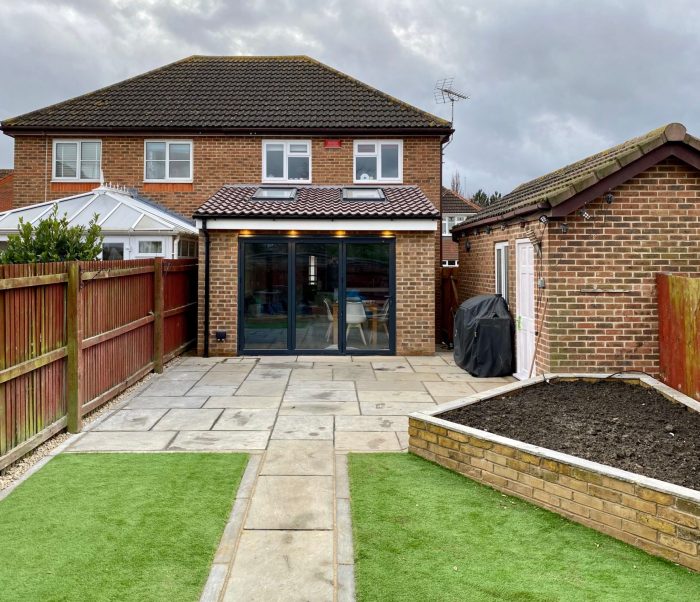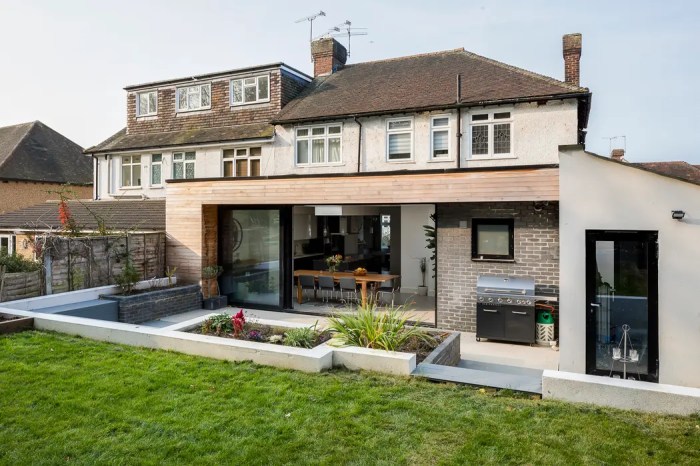Rear extension ideas for semi detached houses – Rear extension ideas for semi-detached houses can add extra space, light, and value to your home. From creating a modern kitchen diner to adding a home office or extra bedroom, there are endless possibilities. We explore the architectural considerations, space planning, structural considerations, materials and finishes, glazing and natural light, sustainability and energy efficiency, landscaping and outdoor spaces, budget and cost considerations, planning permission and building regulations, and showcase inspiring case studies to help you create your dream extension.
Architectural Considerations

Designing a rear extension for a semi-detached house requires careful consideration of both architectural and practical factors. Understanding local building codes and regulations is essential to ensure compliance and avoid any potential issues during the planning and construction process.
To achieve a harmonious and cohesive design, the extension should complement the existing architectural style of the house. This can be achieved by matching the materials, finishes, and overall form of the extension to the original structure. Maximizing natural light is crucial for creating a bright and inviting living space.
Incorporating large windows, skylights, or glazed doors can bring in ample daylight and reduce the need for artificial lighting.
Seamless Transitions
Creating seamless transitions between the old and new spaces is essential for a successful rear extension. This can be achieved by carefully planning the layout and flow of the spaces, ensuring there are no awkward or disjointed areas. Using similar flooring materials, color schemes, and architectural details can help to unify the different spaces and create a cohesive overall design.
Space Planning and Layout
Rear extensions offer a fantastic opportunity to reconfigure and enhance the living space of semi-detached houses. When planning the layout, consider the following options and design principles to create functional and inviting living areas.
Open-plan layoutsseamlessly connect the kitchen, dining, and living areas, promoting a sense of spaciousness and fostering a sociable atmosphere. However, separate roomsprovide more privacy and defined spaces for different activities.
Optimizing Space
- Utilize vertical space:Install floating shelves, mezzanines, or built-in storage to maximize vertical space and minimize clutter.
- Create multi-purpose areas:Designate spaces that serve multiple functions, such as a breakfast bar that doubles as a workspace or a living room that can be converted into a guest room.
- Choose furniture wisely:Opt for furniture that is both functional and space-saving, such as ottomans with built-in storage or nesting tables.
Structural Considerations
Rear extensions can use various structural systems, including brick and blockwork, timber frames, and steel frames. The choice depends on factors such as the size and complexity of the extension, the existing structure, and budget.Brick and blockwork extensions are traditional and durable, but they can be labor-intensive and expensive.
Timber frames are lightweight and easy to install, making them a good choice for smaller extensions. Steel frames are strong and versatile, but they can be more expensive than other options.Proper foundations are crucial for the stability of the extension.
The type of foundation required will depend on the soil conditions and the weight of the extension. Damp-proofing is also essential to prevent moisture from entering the extension and causing damage.Minimizing the impact of the extension on the existing structure is important.
This can be achieved by using lightweight materials, carefully designing the connection between the extension and the existing building, and using vibration-damping measures during construction.
Materials and Finishes
When choosing materials for your rear extension, it’s important to consider both the aesthetic and practical aspects. The materials you choose should complement the existing house and enhance the overall look and feel of your home. They should also be durable and easy to maintain.There
are a wide range of materials available for rear extensions, including brick, render, cladding, and glazing. Each material has its own unique advantages and disadvantages.
Brick
Brick is a traditional material that is often used for rear extensions. It is durable, easy to maintain, and can be painted or rendered to match the existing house. However, brick can be expensive and time-consuming to install.
Render
Render is a mixture of cement, sand, and water that is applied to the exterior walls of a house. It is a popular choice for rear extensions because it is relatively inexpensive, easy to apply, and can be painted any color.
However, render can be susceptible to cracking and peeling.
Cladding
Cladding is a material that is applied to the exterior walls of a house to improve its appearance and protect it from the elements. There are a wide range of cladding materials available, including wood, metal, and composite materials. Cladding is relatively easy to install and can be a cost-effective way to improve the look of your home.
However, some cladding materials can be flammable or require regular maintenance.
Glazing
Glazing is a material that is used to create windows and doors. It is a popular choice for rear extensions because it allows natural light to flood into the space. However, glazing can be expensive and can make a room feel cold in winter.When
choosing materials for your rear extension, it is important to consider your budget, the style of your home, and the climate in your area. It is also a good idea to consult with an architect or builder to get professional advice.
Glazing and Natural Light
Maximizing natural light in rear extensions is crucial for several reasons. It creates a brighter, more inviting space, reduces energy consumption by minimizing the need for artificial lighting, and improves overall well-being.Different types of glazing can be used to achieve this, including windows, doors, and skylights.
Windows allow for both light and ventilation, while doors provide access to the outdoors and can create a seamless transition between indoor and outdoor spaces. Skylights bring in natural light from above, illuminating areas that may not receive direct sunlight from windows.When
positioning and sizing windows, consider the orientation of the extension and the amount of sunlight it receives. North-facing extensions will require larger windows to compensate for less direct sunlight, while south-facing extensions can benefit from smaller windows to avoid overheating.
Additionally, consider the placement of windows to maximize views and create a sense of connection with the outdoors.
Sustainability and Energy Efficiency
Rear extensions provide an excellent opportunity to incorporate sustainable features that enhance the energy efficiency and environmental performance of your home. By embracing eco-friendly practices, you can reduce running costs, minimize your carbon footprint, and create a healthier living environment.
To achieve a sustainable and energy-efficient rear extension, consider the following aspects:
Energy-Efficient Appliances and Renewable Energy
- Install energy-efficient appliances with high energy star ratings, such as refrigerators, dishwashers, and washing machines.
- Consider incorporating renewable energy sources like solar panels or a ground source heat pump to generate electricity or heat water.
- Utilize natural ventilation and daylighting to reduce energy consumption for lighting and cooling.
Insulation, Ventilation, and Airtightness
Proper insulation is crucial for minimizing heat loss and maintaining a comfortable indoor temperature. Consider using high-performance insulation materials in walls, ceilings, and floors.
Adequate ventilation ensures fresh air circulation and reduces moisture buildup, preventing mold and improving indoor air quality. Install energy-efficient ventilation systems or incorporate passive ventilation strategies.
Airtightness prevents drafts and heat loss. Seal gaps around windows, doors, and other openings to improve the overall energy efficiency of the extension.
Sustainable Materials
Opt for sustainable building materials with low environmental impact, such as recycled or locally sourced materials. Consider using eco-friendly finishes, such as low-VOC paints and natural wood flooring.
Choose materials that are durable and require minimal maintenance, reducing the need for replacements and repairs over time.
High Level of Energy Efficiency
By combining energy-efficient appliances, renewable energy sources, insulation, ventilation, and sustainable materials, you can achieve a high level of energy efficiency in your rear extension. This not only reduces running costs but also contributes to a greener and more sustainable lifestyle.
Consult with professionals to assess your energy needs and determine the most effective solutions for your specific requirements.
Landscaping and Outdoor Spaces

To create a seamless transition between the rear extension and the garden, consider using materials and colors that complement both spaces. For instance, extend the flooring from the extension into the garden, or use similar colors for the walls and outdoor furniture.
This will help to visually connect the two areas and make them feel like one cohesive space.When planning your landscaping, it is important to consider how you will use the space. If you enjoy entertaining, you may want to create a patio or decking area with seating and a barbecue.
If you have children, you may want to include a play area or a trampoline. And if you simply want to relax and enjoy the outdoors, you may want to create a peaceful seating area with a fire pit or water feature.
Patios
- Patios are a great way to create a defined outdoor living space. They can be made from a variety of materials, such as concrete, pavers, or wood.
- Patios are relatively easy to build and can be customized to any size or shape.
- They are also a great place to add outdoor furniture, such as a table and chairs, a lounge chair, or a hammock.
Decking
- Decking is another great option for creating an outdoor living space. It is made from wood and can be installed on a variety of surfaces, such as concrete, pavers, or even the ground.
- Decking is more expensive than patios, but it is also more durable and requires less maintenance.
- It is also a great way to add a touch of luxury to your outdoor space.
Planting Schemes
- Planting schemes can be used to create a variety of different looks and effects in your garden.
- For example, you can use plants to create privacy, add color, or attract wildlife.
- When choosing plants for your planting scheme, it is important to consider the amount of sunlight and water that they will receive, as well as the size and shape of your garden.
Budget and Cost Considerations
Extending your home can be an exciting and transformative project, but it’s crucial to plan your budget carefully to avoid unexpected expenses and ensure your project stays on track. The cost of a rear extension can vary significantly depending on several factors.
The size and complexity of the extension are major cost drivers. A larger extension will naturally cost more, and a more complex design with bespoke features will also add to the overall expense.
Materials and Finishes
The materials you choose for your extension will also impact the cost. Higher-quality materials, such as natural stone or hardwood flooring, will generally cost more than standard materials.
Tips for Budgeting Effectively
To avoid overspending and ensure your project stays within your budget, consider the following tips:
- Get detailed quotes from multiple contractors before making a decision.
- Set a realistic budget and stick to it.
- Be prepared for unexpected expenses and have a contingency fund in place.
- Consider the long-term value of the extension when making decisions about materials and finishes.
Planning Permission and Building Regulations
Planning permission and building regulations approval are essential steps in any rear extension project. Planning permission ensures that your extension complies with local planning policies, while building regulations approval ensures that it meets minimum safety and construction standards.
Obtaining Planning Permission
The process of obtaining planning permission involves submitting an application to your local planning authority. The application should include detailed plans of your proposed extension, as well as a supporting statement explaining how it meets planning policies. The planning authority will then assess your application and make a decision within a specified timeframe.
Building Regulations Approval, Rear extension ideas for semi detached houses
Once you have obtained planning permission, you will need to apply for building regulations approval. This involves submitting detailed plans of your extension to your local building control body. The building control body will then assess your plans and ensure that they meet minimum safety and construction standards.
Case Studies and Inspiration
Get inspired by these stunning examples of rear extensions for semi-detached houses, showcasing innovative design principles and construction methods.
These case studies provide a glimpse into the transformative power of rear extensions, enhancing living spaces, maximizing natural light, and creating seamless transitions between indoor and outdoor areas.
Example 1: Modern Glass Extension
- Design: A contemporary glass extension with a sleek and minimalist aesthetic.
- Construction: Steel and glass construction, creating an airy and light-filled space.
- Features: Floor-to-ceiling windows, sliding doors, and an open-plan layout.
Example 2: Traditional Extension with Brick and Timber
- Design: A traditional extension that seamlessly blends with the existing house.
- Construction: Brick and timber construction, providing a warm and inviting atmosphere.
- Features: Arched windows, exposed beams, and a cozy fireplace.
Final Conclusion: Rear Extension Ideas For Semi Detached Houses
Whether you’re looking to extend your kitchen, add a new living room, or create a home office, these rear extension ideas for semi-detached houses will inspire you to create a beautiful and functional space that meets your needs. With careful planning and execution, you can transform your home into a more comfortable, inviting, and valuable asset.
FAQ Resource
How much does a rear extension cost?
The cost of a rear extension varies depending on the size, complexity, and materials used. However, as a general guide, you can expect to pay between £1,500 and £2,500 per square meter.
Do I need planning permission for a rear extension?
In most cases, you will need planning permission for a rear extension. However, there are some exceptions, such as if the extension is less than 4 meters deep and does not exceed 50% of the original property’s footprint.
What are the benefits of a rear extension?
Rear extensions can add extra space, light, and value to your home. They can also improve the flow of your home and make it more comfortable and inviting.


